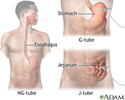Jejunostomy feeding tube
Feeding - jejunostomy tube; G-J tube; J-tube; Jejunum tube
A jejunostomy tube (J-tube) is a soft, plastic tube placed through the skin of the abdomen into the midsection of the small intestine. The tube delivers food and medicine until the person is healthy enough to eat by mouth.
You'll need to know how to care for the J-tube and the skin where the tube enters the body.
Follow any specific instructions your health care provider or nurse gives you. Use the information below as a reminder of what to do.
What to Expect at Home
It is important to take good care of the skin around the tube to avoid getting an infection or skin irritation.
You will also learn how to change the dressing around the tube every day.
Make sure you keep the tube protected by taping it to the skin.
Your nurse may replace the tube every now and then.
Cleaning the Skin Around the J-tube
To clean the skin, you will need to change the bandages once a day or more if the area becomes wet or dirty.
The skin area should always be kept clean and dry. You will need:
- Warm soapy water and a washcloth
- Dry, clean towel
- Plastic bag
- Ointment or hydrogen peroxide (if your doctor recommends)
- Q-tips
Follow these guidelines every day for good health and skin care:
- Wash your hands well for a few minutes with soap and water.
- Remove any dressings or bandages on the skin. Place them in the plastic bag and throw the bag away.
- Check the skin for redness, odor, pain, puss, or swelling. Make sure the stitches are still in place.
- Use the clean towel or Q-tip to clean the skin around the J-tube 1 to 3 times a day with mild soap and water. Try to remove any drainage or crusting on the skin and tube. Be gentle. Dry the skin well with a clean towel.
- If there is drainage, place a small piece of gauze under the disc around the tube.
- Do not rotate the tube. This may cause it to become blocked.
Replacing the Dressings Around the Tube
You will need:
- Gauze pads, dressings, or bandages
- Tape
Your nurse will show you how to place the new bandages or gauze around the tube and tape it securely to the abdomen.
Usually, split gauze strips are slipped over the tube and taped down on all four sides. Tape the tube down as well.
Do not use creams, powders, or sprays near the site unless the nurse says it is OK.
Flushing the J-tube
To flush the J-tube, follow the instructions your nurse gave you. You will use the syringe to slowly push warm water into the side opening of the J-port.
You may rinse, dry, and reuse the syringe later.
When to Call the Doctor
Contact your provider right away if any of the following occur:
- The tube is pulled out
- There is redness, swelling, smell, pus (unusual color) at the tube site
- There is bleeding around the tube
- The stitches are coming out
- There is leaking around the tube
- Skin or scarring is growing around the tube
- Vomiting
- Stomach is bloated
References
Smith SF, Duell DJ, Martin BC, Gonzalez L, Aebersold M. Nutritional management and enteral intubation. In: Smith SF, Duell DJ, Martin BC, Gonzalez L, Aebersold M, eds. Clinical Nursing Skills: Basic to Advanced Skills. 9th ed. New York, NY: Pearson; 2017:chap 16.
Ziegler TR. Malnutrition: assessment and support. In: Goldman L, Schafer AI, eds. Goldman-Cecil Medicine. 26th ed. Philadelphia, PA: Elsevier; 2020:chap 204.
Review Date: 11/3/2022
Reviewed By: Michael M. Phillips, MD, Emeritus Professor of Medicine, The George Washington University School of Medicine, Washington, DC. Also reviewed by David C. Dugdale, MD, Medical Director, Brenda Conaway, Editorial Director, and the A.D.A.M. Editorial team.


